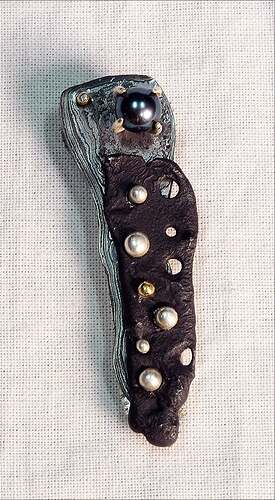Materials: Pattern Welded Steel, Sterling Silver, Reticulation Silver, Fine Silver, 14k Gold, Black Pearl, Diamond, Stainless Steel
Dimensions: 2" x 0.5" x 0.2"
Both the front and back (reverse not shown) of this piece are reticulated silver. The process of reticulation involves a higher copper alloy. The alloy is treated by heating and quenching in acid to bring the fine silver to the surface. Once adequately treated, the silver is carefully heated to melt the lower temperature inner alloy, leaving the higher temperature fine silver floating on the surface, free to drift into any ripple or form it so chooses. By treating a piece of metal to create a different inner and outer alloy, organic effects can be achieved. This piece is also an example of juxtaposition of fine and raw materials. The individual parts of this piece were are all created independently of each other and came together as a composition. It was both there similarities in form as well as there contrasting materials and colors that forms the piece.
Photo credit: Jake Martin
Jake Martin
Rochester, NY. USA
I am currently in my last year as an undergraduate student studying jewelry and metal-smithing at Rochester Institute of Technology’s School of American Crafts. The inspiration for my work is drawn from a wide variety of sources. These range from the rusty, dilapidated steel architecture of my rust belt home-town to the fine gold-smithing of Classical Greece and Renaissance Italy. These inspirational elements are what initially interested me in metal and continue to do so, but are not by any means the extent of my influence.
Stemming from playing in the dirt, with rocks and insects as a child, I have been interested in science, biology, chemistry, and geometry. Natural geometry is especially interesting to me because the time tested patterns and methods of nature have been recognized and utilized repeatedly throughout history by artists, shamans, and scientists alike. Seeing how creating art is my own personal way of better understanding my own existence, it makes sense to use the same pathways and draw inspiration from the same sources as would a scientist.
In my work, I make an attempt to be honest and un-bias in my use of materials. Silver can be fused to the surface of recycled steel, an iron nail can be set like a gem stone, raw gold veins can sit intermingling with diamonds and pearls as well as rust and slate and naturally occurring textures are emphasized, not removed. The work is often a result of a contemplative process of arrangement and rearrangement rather than an execution of steps. The pieces serve as a record of a process as much a conclusive product in much the same way a found piece of scrap metal hints at its past as much as its present condition.
I use metal because of its malleability. I can go back and forth on both an idea and a physical piece of material, doing, undoing, and redoing, utilizing the widest variety of possibilities. I am attracted to the raw nature of the material, its versatility, resilience and shapelessness.
The presence of the maker’s hand is essential to my work. Instead of hiding the inevitable imperfections that occur during the process, they are repeated and emphasized. I utilize repeated elements and patterns as well as juxtaposing fine elements of jewelry against raw and unrefined objects to infuse a sense of internal life and movement within my work.
Ganoksin hosts the jewelry list Orchid, with over 13,000 list members from all over the world, speaking from a wide range of technical and aesthetic experiences. The exhibition theme grew out of a desire to celebrate the creativity encompassed in this wide variety.
Artists were free to interpret the theme in any way they chose. Each artist could submit up to six pieces. Interpretations include uniting different materials into one cohesive form; intellectual and emotional “unitings”, where the meaning of the piece unites multiple concepts; the uniting of time - past, present and future; and a number that focus on the harmony created when uniting multiple materials and/or concepts.
The work submitted involved a wide range of jewelry techniques, from very traditional to very cutting edge, as well as using materials from traditional precious metals and gemstones to “re-purposed” and “up-cycled” materials.
The exhibition showcases 330 images chosen from entries from over 111 artists representing 26 countries.
Argentina, Australia, Belgium, Brazil, Canada, Colombia, Czech Republic, France, Greece, India, Israel, Italy, Malta, Mauritius, Mexico, Netherlands, New Zealand, Philippines, Serbia, Spain, Trinidad, Turkey, UK, USA, Venezuela, and the Virgin Islands
Many of the participants began their interest in jewelry at a young age. Some are relative newcomers to the field, and some have over 35 years of experience as professional jewelers and goldsmiths. While some grew up in families that were goldsmiths, and followed in those footsteps, others only began creating jewelry as adults.
